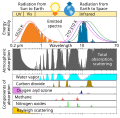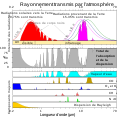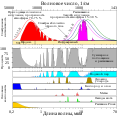File:Atmospheric Transmission.svg

Size of this PNG preview of this SVG file: 614 × 600 pixels. Other resolutions: 246 × 240 pixels | 491 × 480 pixels | 786 × 768 pixels | 1,048 × 1,024 pixels | 2,096 × 2,048 pixels | 741 × 724 pixels.
Original file (SVG file, nominally 741 × 724 pixels, file size: 321 KB)
File history
Click on a date/time to view the file as it appeared at that time.
| Date/Time | Thumbnail | Dimensions | User | Comment | |
|---|---|---|---|---|---|
| current | 16:19, 18 April 2023 |  | 741 × 724 (321 KB) | Efbrazil | Adding white background color so renders correctly on smartphone |
| 20:29, 7 August 2022 |  | 741 × 724 (321 KB) | Efbrazil | color bug fix | |
| 20:00, 7 August 2022 |  | 741 × 724 (321 KB) | Efbrazil | Fixed translations as best as possible using text editor for new layout | |
| 19:34, 7 August 2022 |  | 741 × 724 (320 KB) | Efbrazil | Fixing text alignment | |
| 19:26, 7 August 2022 |  | 741 × 724 (320 KB) | Efbrazil | Graphical improvements as per discussion page | |
| 17:59, 17 February 2022 |  | 741 × 724 (208 KB) | Pierre cb | File uploaded using svgtranslate tool (https://svgtranslate.toolforge.org/). Added translation for fr. | |
| 22:10, 18 March 2021 |  | 741 × 724 (180 KB) | Cepheiden | german labels adjusted | |
| 22:09, 18 March 2021 |  | 741 × 724 (180 KB) | Cepheiden | correction of labels | |
| 22:06, 18 March 2021 |  | 741 × 724 (180 KB) | Cepheiden | File uploaded using svgtranslate tool (https://svgtranslate.toolforge.org/). Added translation for de. | |
| 21:52, 18 March 2021 |  | 741 × 724 (154 KB) | Cepheiden | =={{int:filedesc}}== {{Information |description= {{en|1=This figure shows the absorption bands in the Earth's atmosphere (middle panel) and the effect that this has on both solar radiation and upgoing thermal radiation (top panel). Individual absorption spectrum for major greenhouse gases plus Rayleigh scattering are shown in the lower panel.}} |date=2021-03-18 |source=This figure was prepared by Robert A. Rohde for the Global Warming Art project. |author=[[User:Д.Ил... |
File usage
The following 4 pages use this file:
Global file usage
The following other wikis use this file:
- Usage on ar.wikipedia.org
- Usage on de.wikipedia.org
- Usage on el.wikipedia.org
- Usage on fr.wikipedia.org
- Usage on gl.wikipedia.org
- Usage on ha.wikipedia.org
- Usage on ig.wikipedia.org
- Usage on pt.wikipedia.org
- Usage on simple.wikipedia.org
- Usage on zh.wikipedia.org










